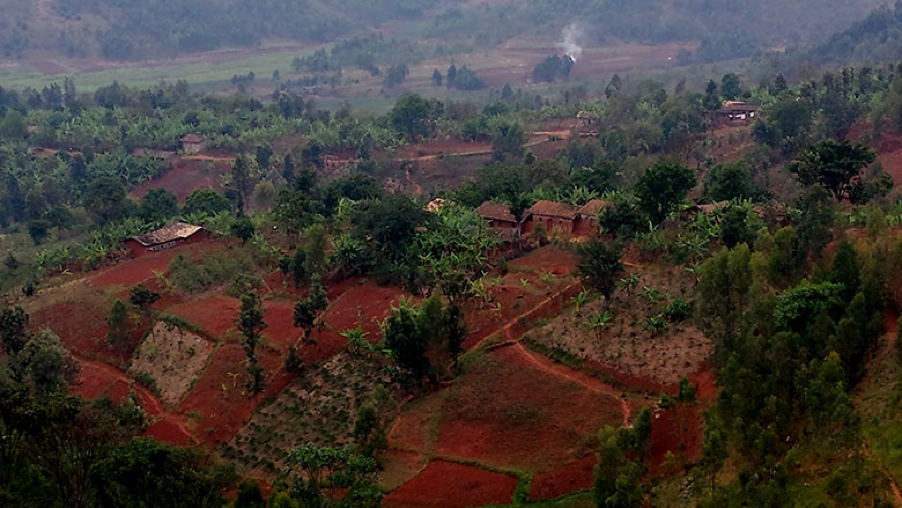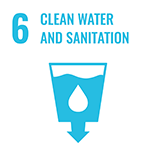Planting shade for coffee – The Sustainable Coffee Landscapes Project in Burundi

Summary
The Sustainable Coffee Landscape Project (PADZOC) was implemented in the highlands of the Bubanza, Bururi and Muyinga provinces of Burundi from 2013 to 2018. It had the main objective to pilot sustainable land and water management practices in the country’s coffee landscape.
Due to land degradation and loss of vegetation cover, the hilly areas of Burundi experience heavy soil loss issues. Unsustainable agricultural and land-use practices and a very high annual population growth of around 3.3%, which causes population pressure in the already densely populated country, are major factors contributing to such erosion problems. Moreover, a predicted precipitation increase of around 10% and distortions to the existing precipitation regime due to climate change further exacerbate the related challenges.
The heart of Burundian agricultural export is the coffee bean. About 20% of the country’s total export comes from coffee. However, there are many concerns, both climatic and production-related, regarding the production of this commodity in the country, as due to severe land degradation, there has been a decline in production, having major ramifications on the livelihoods of many people, and production is extremely volatile.
The Sustainable Coffee Landscape Project (PADZOC) aimed to tackle these issues and targeted the coffee sector by focusing on four main aspects: (1) degraded coffee landscapes due to sun-grown coffee monocropping; (2) degraded protected areas due to the encroachment of agricultural land and firewood collection; (3) polluted downstream water due to the environmentally unsound practices of coffee water stations; and (4) low-quality coffee production and limited marketing. All of the targeted provinces were selected because they are all coffee-producing provinces that either contain or surround protected areas. To combat erosion in hillside plantations, coffee farmers in these provinces were trained in a shade-cropping technique and in sustainable land and water management. Shade cultivation systems are polyculture techniques that consist of intercropping coffee crops with other crops, such as bananas, beans or corn, which shade the coffee plants and protect them from the sun and strong winds.

Overview
- Location:
- Implementation sites:
-
- Single country
- Single location
- Mountain region:
-
Highlands in Bubanza, Bururi, Kayanza, and Muyinga Provinces
- Solution scale:
- Ecosystem type(s):
- Solution type(s):
- Sector(s):
- Climate impact(s) addressed:
- Other climate impact(s) addressed:
-
- Land degradation
- Climate impact time-scale(s):
- Main benefit associated with the solution:
- Co-benefit(s) associated with the solution implementation:
- Implementation timeline:
-
- 2013 - 2018
Solution details
Main beneficiaries & outcomes
Between 2013 and 2018, more than 18,700 people in the provinces of Bubanza, Bururi and Muyinga benefited from the project’s solutions, and more than 4,400 hectares were restored through sustainable land management practices. Shade-grown coffee production increased by 26%, and of the 9,600 households that adopted the practice, half were headed by women. In addition, over 2 million coffee trees were planted, and each tree in shaded production areas increased its production by 101 grams on average. These practices have benefited the environment by restoring landscapes, and households have seen increased food security, income from coffee production and resilience to climate change.
To ensure that members of the rural communities fully embrace sustainable practices for coffee growing, a manual and booklet for profitable shade-grown coffee farming were elaborated and translated into French and Kirundi (the local language), making it easier for the communities to engage in sustainable coffee farming and contribute to the restoration of landscapes. The project also targeted the indigenous Batwa community, a group that has historically faced exclusion. Through PADZOC, several Batwa members participated in the proposed intervention and households got the opportunity to save up money and purchase their own land.
Planning and implementation
The project was implemented by Burundi’s Ministry of Environment, Agriculture and Livestock, with support from the World Bank. It was decided by the project stakeholders at the appraisal phase that the existing World Bank-funded AgroPastoral Productivity and Markets Development Project (PRODEMA) would serve as the Project Coordination Unit (PCU). At the local level, field coordination, guidance and supervision of project activities were assigned to Inter-Provincial Coordination Units (one at each province).
The different outputs and strategies of the solution were organized into its four main components:
- Component 1: Sustainable Coffee Landscape Management
- Component 2: Addressing Pollution Point Sources in Coffee Washing Stations
- Component 3: Diversification of Livelihoods
- Component 4: Knowledge and Learning
Finance
The project was financed through two trust funds, a GEF trust fund of US$4.2 million, and a TerrAfrica Leveraging Trust Fund (TLF) of US$33,000. Costs by component were distributed as follows:
|
Component |
Amount (US$M) |
|
Component 1: Sustainable Coffee Landscape Management |
2.9 |
|
Component 2: Addressing Pollution Point Sources in Coffee Washing Stations |
0.29 |
|
Component 3: Diversification of Livelihoods |
0.39 |
|
Component 4: Knowledge and Learning |
0.63 |
|
Total |
4.23 |
Innovation
This solution can be considered as innovative given that, addressing landscape restoration through coffee planting, while at the same time improving household incomes and livelihoods, increases the local acceptance of the proposed initiatives and could be a successful example to be followed elsewhere.
Performance evaluation
Monitoring and evaluation of the project strategies and implemented activities were part of component 4 and included the completion of an impact evaluation. This was conducted by surveying a total of 2,223 households in 2014 and 2018 with a view to measuring changes in indicators such as the adoption of shade coffee production, number of shade coffee trees, coffee production per tree, household food security, among others. Such assessment was the first of its kind in the environmental sector in Burundi.
Long term project sustainability and maintenance
The sustainability of the project interventions has been pursued through the promotion of ownership by the beneficiaries in the targeted areas, who, according to the Implementation Completion and Results Report, are highly aware of and willing to continue the activities after the closure of the solution. The government, at the same time, remains committed to the sustainability of the interventions piloted and has announced their scaling up in the framework of a new project.
Capacities for design and implementation
Knowledge
An important aspect that motivated the Government of Burundi to apply for the Project was an exchange visit to Colombia to witness successful shade coffee cultivation practices in Colombia (financed by the World Bank’s multi-donor fund for South-South experience sharing). Later, during implementation, the pre-existing experience and knowledge capabilities of the PCU were some of the factors that helped in realizing the solution and overcoming the challenges faced in 2015 and 2016. This was due to the fact that the group had already been involved in the implementation of other World Bank projects.
Technology
To incorporate new information and data relevant to the carried-out activities, including that related to biodiversity and sustainable land and water management, an already functional and working management information system (MIS) was employed.
Political / Legal
The project received wide support from the country’s government, which, in addition to taking responsibility for its implementation through the Ministry of Agriculture and Livestock, also co-financed part of the piloted measures and has committed to providing support in the future. Eco-guards, trackers, and the cooperative managing the thermal waters, which were initially piloted by the project, are now being financed by the government. The Burundian Office for Environmental Protection (OBPE) and the Regulation Authority of the Coffee Value Chain (ARFIC) formed part of the main solution stakeholders.
Institutional
Apart from the aforementioned key actors, collaboration was carried out with InterCafé, an autonomous professional organization, and with the Agricultural Research Institute (ISABU). InterCafé was directly involved in the implementation of the sustainable shade-grown coffee production program, in activities related to coffee certification and marketing, in the piloting of agro-tourism initiatives on coffee farms, and in the communication strategy, while ISABU supported research activities and the creation of a shade-grown coffee cultivation manual intended to transfer knowledge to local farmers.
Socio-cultural
Members of the beneficiary communities and agricultural groups and cooperatives were equally actively engaged in the project and participated in the training and sensitization activities, eventually demonstrating a clear interest in incorporating the piloted activities into their agricultural strategies. The indigenous Batwa community was integrated and organized into community groups. They received financial support from the project in exchange for helping to protect the Bururi Natural Reserve.
Outlook & Scalability
Barriers and adverse effects
Some of the main challenges encountered during the execution of the solution include a political crisis in 2015 that slowed down its implementation process, and a prolonged drought in 2016, which disrupted planting activities. To compensate for such delays, an 18-month extension of the closing date was granted, resulting in a satisfactory overall outcome.
Other implementation difficulties included the resignation of the financial management specialist and the monitoring and evaluation specialist in 2015 and 2016, respectively. Although this problem was overcome, the fact that it took several months to hire new experts each time represented additional temporary responsibilities for project staff and some delays in data collection.
Transformation and future outlook
The solution is considered transformative in the Burundian context for several reasons. First, thanks to PADZOC’s efforts to raise awareness and improve the capacities and training of the general population and decision-makers, the project successfully contributed to changing the perception of local communities and institutions on the use of shade coffee, thus modifying the long-standing unsustainable behavior of monoculture and sun-grown coffee. Furthermore, lessons have been systematized with the inclusion of the piloted farming strategies in the national agenda. A set of regulations and standards have also been generated to effectively grow and process shade coffee.
Potential for upscaling and replication
The restoration of degraded landscapes introduced through this solution will be expanded and used to support the sustainable management of the Bururi Forest Reserve and the Kibira and Ruvubu National Parks in the Burundi Landscape Restoration and Resilience Project (BLRRP), which will be supported by the World Bank and has an estimated cost of US$30 million. Lessons learned will also be useful for other ongoing and future projects in the country such as the Coffee Sector Competitiveness Project (PACSC) and the Agro-Pastoral Productivity and Markets Development Project (PRODEMA). Moreover, according to the impact assessment conducted at the closure of the solution, the activities introduced had an indirect effect on other areas not covered by the project and farmers were beginning to adopt shade-grown coffee by their own initiative.









Comments
There is no content